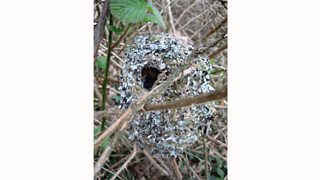Guest bloggers: Ben Hatchwell and Pip Gullet, University of Sheffield.
Long-tailed tits are the cutest of British birds. Easily. They're also one of the most unusual, with a cooperative breeding system in which some adults help raise the chicks of their relatives instead of raising their own. They're very sociable in winter too, and you might have seen a large flock of them passing noisily through your garden, pausing briefly to feed on peanuts or fat balls. But the most exciting time to watch lotties (that's long-tailed tits) is in spring.

long-tailed tit by Marc Davidson, from the Springwatch Flickr group.
Spring is when flocks break up and pairs form, and the nest-building marathon begins. This can take 4-5 weeks of hard labour, weaving moss and plant fibres together with spiders' silk from egg cocoons (magic!) and covering the entire structure in lichen for camouflage. The diligent pair then line their nest with up to 2,500 feathers, collected over several days and carefully arranged to make a soft, warm cup. The result is a cosy ball around 15cm high and 10cm wide, with a small entrance hole near the top.

Long-tailed tit nest
Time to lay the eggs! The female lotti lays one every morning, each weighing less than a paperclip and not much bigger than a peanut. She lays around 10 of these tiny eggs (together weighing well over her own body mass), and then incubates for about two weeks.
Incubation is an arduous task, and although her mate may bring her a mouthful of insects now and then, she must leave the nest every 15 minutes or so for an avid foraging session. It's when she's away from the nest that the reason for the extraordinary investment in nest-building becomes apparent: the better crafted the nest, the slower the eggs cool and the less energy the female must spend to warm them up again. It's also the time when a long-tailed tit becomes a bent-tailed tit: so much time cooped up in the nest adds a comical curl to the female's elegant long tail.
This is the twentieth successive year that Ben and his colleagues at the University of Sheffield have studied long-tailed tits in the Rivelin Valley, and what better way to celebrate than seeing them on national TV.
